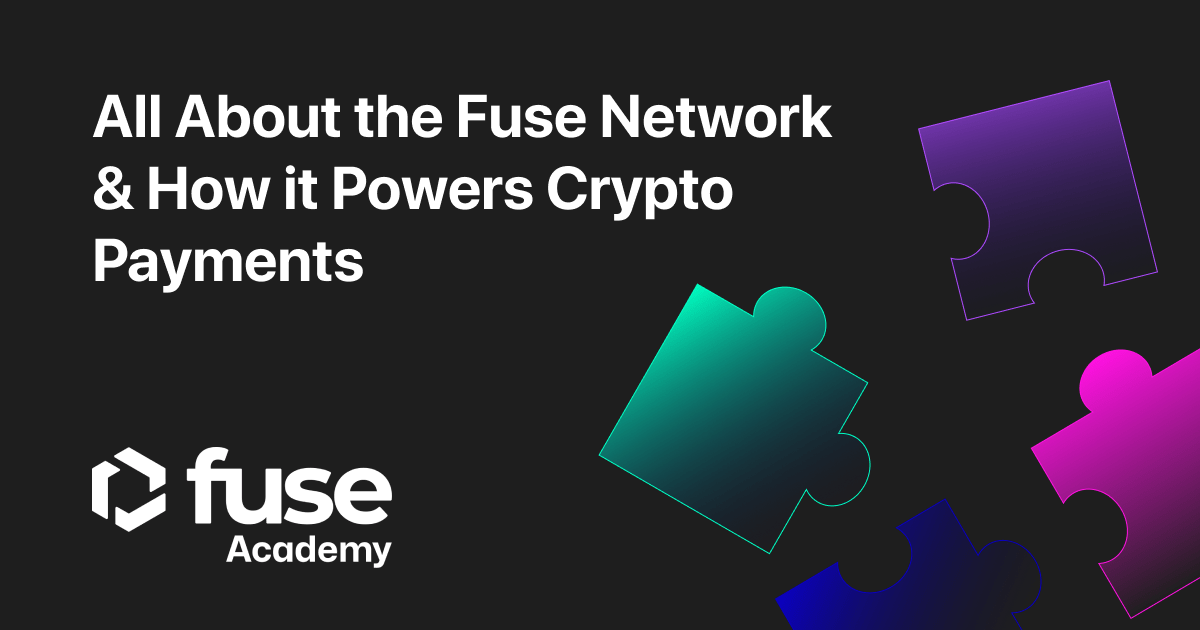Have you ever wondered how to use your crypto to make payments for everyday goods? Fuse Network is dedicated to making this process as simple and decentralized as possible. But what is the Fuse Network, and how does it enable crypto payments? What about the FUSE token?
In this article, you’ll get a complete overview of Fuse, its dApps, and how it is developing the decentralized finance (DeFi) ecosystem. Let’s get started!
What is the Fuse Network?
The Fuse Network is a decentralized public blockchain that allows for the development of crypto applications. It was created in 2019 and is one of the key components of the Fuse platform.
Since Fuse’s mission is to bring crypto payments and DeFi to the masses, the blockchain runs as a side chain of Ethereum and supports smart contracts written in Solidity. This facilitates interoperability with other EVM-compatible chains.
Fuse promises to reduce the friction, cost, and limitations that businesses face while accepting mobile payments.
With the Fuse Network blockchain, you can rest assured that transactions are processed quickly and affordably.
Just five seconds is all it takes for your transaction to be confirmed; at an average cost of less than a cent per confirmation, there’s no need to worry about running up high fees.
How does the Fuse network work?
The Fuse Network blockchain is a distributed digital ledger that stores blocks of data on its nodes, validated through a variant of delegated Proof of Stake (dPoS) consensus mechanism.
In other words, any changes to the data on the blockchain must be approved by a significant number of independent validators, only one of which is run by the Fuse Foundation.
Validators are chosen based on their stake in the network instead of their computing power and are usually users who want to take an active role in the future of the network.
Fuse’s nodes not only process transaction info but also permanently store and update the code and current state of smart contracts.
This makes Fuse ideal for tracking transactions and providing a secure platform for storing digital assets.
What is the FUSE Token?
The Fuse Network also has its native token called FUSE. It serves as a medium of exchange within the network and a reward for users who contribute by running validators or developing applications on the platform.
FUSE is available on many popular cryptocurrency exchanges, such as Uniswap, PancakeSwap, Huobi Global, 1inch, Sushi, and more cryptocurrency exchanges.
And besides the Fuse Network, you can also find wrapped versions of the token on Ethereum, BNB Chain, Polygon, and Arbitrum One.
Token holders may stake their FUSE and earn a passive income of more than 14% annually. One of the easiest ways to get some FUSE is through Voltage Finance.
What is the Fuse network used for?
Since the entire Fuse ecosystem was founded with driving mainstream adoption of Web3 payments in mind, most blockchain projects are related to decentralized Finance (DeFi).
But that doesn’t mean that Web3 games and NFTs can’t also take advantage of Fuse technology. There are currently around one hundred projects on Fuse in the most varied areas.
Get to know some of the top projects on the Fuse network:
Voltage Finance
With Fuse’s lightning-fast blockchain and minimal transaction cost, Voltage Finance stands out as one of the most relevant DEX solutions. Its non-custodial wallet, Volt App, is available on mobile devices and reduces friction for non-experienced traders with a host of one-click features.
GoodDollar
GoodDollar is one of the most used projects on Fuse, generating many transactions that the blockchain handles effortlessly. This non-profit protocol, created by eToro’s founder and CEO, enables people to access and utilize cryptocurrency through any mobile device.
To make it easy for anyone to become part of today’s financial landscape, its framework was designed to fund and distribute global basic income via the GoodDollar token.
Bitazza
Another good example of real-world implementation of wallets and crypto payments is Bitazza. The digital asset platform is prevalent in Southeast Asia. It aims to become the platform of choice for managing crypto-assets in a regulated environment – all while taking advantage of Fuse’s blockchain speed and low fees.
Sushi
Sushi is among the world’s most popular decentralized exchanges (DEX). Originally built on Ethereum, it has also run on Fuse Network since 2021. Connected to Fuse, the DEX users can swap tokens and farm LP yield on FUSE pairs directly.
Fuse Charge and Blockchain as a Service
To apply all the philosophy and technology behind the Fuse ecosystem, Fuse Labs launched the blockchain payments API platform Fuse Charge in 2022.
The goal was to provide businesses and developers with payment abilities not accessible in the current banking system – thanks to the Fuse network. It has onboarded several businesses on the future of finance and is a great sneak peek of what Fuse’s real-world applications can achieve.
Conclusion
The Fuse Network’s potential impact on the crypto world is exciting. By betting on interoperability, it’s contributing to an efficient and secure Web3 infrastructure and, consequently, greater adoption of cryptocurrency payments.
Fuse is already showing its worth by powering some of the most popular DeFi projects among businesses and will continue to do so in the future. So, it’s worth keeping an eye on.
Learn more about Fuse with further reading
.svg)
.svg)











